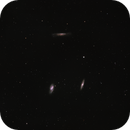Process:
- Stack and align with WBPP
- Graxpert
- StarXTerminator to remove the stars
- Clone stamp to clean up the one dust mote that no amount of flats seems to remove (I've gotta pull my camera to clean the sensor window)
- Pixel math to bring the stars back in
- Channel combination to create the RGB image
- Background normalization
- Color calibration
- BlurXTerminator
- StarXTerminator on Ha and RGB
- SetiAstro's Continuum Subtraction script for Ha
- SetiAstro's Star Stretch script on the stars only image
- SetiAstro's Statistical Stretch script on the starless images
- Curves transformation on RGB
- Curves transformation on Ha
- Curves transformation on Lum
- LRGB combination to add L to RGB
- Combine H-Alpha script to bring the Ha in to RGB
- Some more curves to address the background a little bit
- HLP's Stars Back script to bring the stars back in
- NoiseXTerminator to clean up
- SetiAstro's signature add script (forget the name off the top of my head)
- GIMP to shrink the image down a little from its original size (96 MP after drizzle integration!)
This workflow is based on a SetiAstro YouTube video that I found works well for me. I know I could use SPCC instead of Color Calibration but I had some funky issues with getting the astrometric solution on my image, so I skipped that for now. I also know I'm using a lot of scripts instead of using the processes behind them, but, aside from Continuum Subtraction, I could replace most scripts with the underlying processes if the scripts went away.



